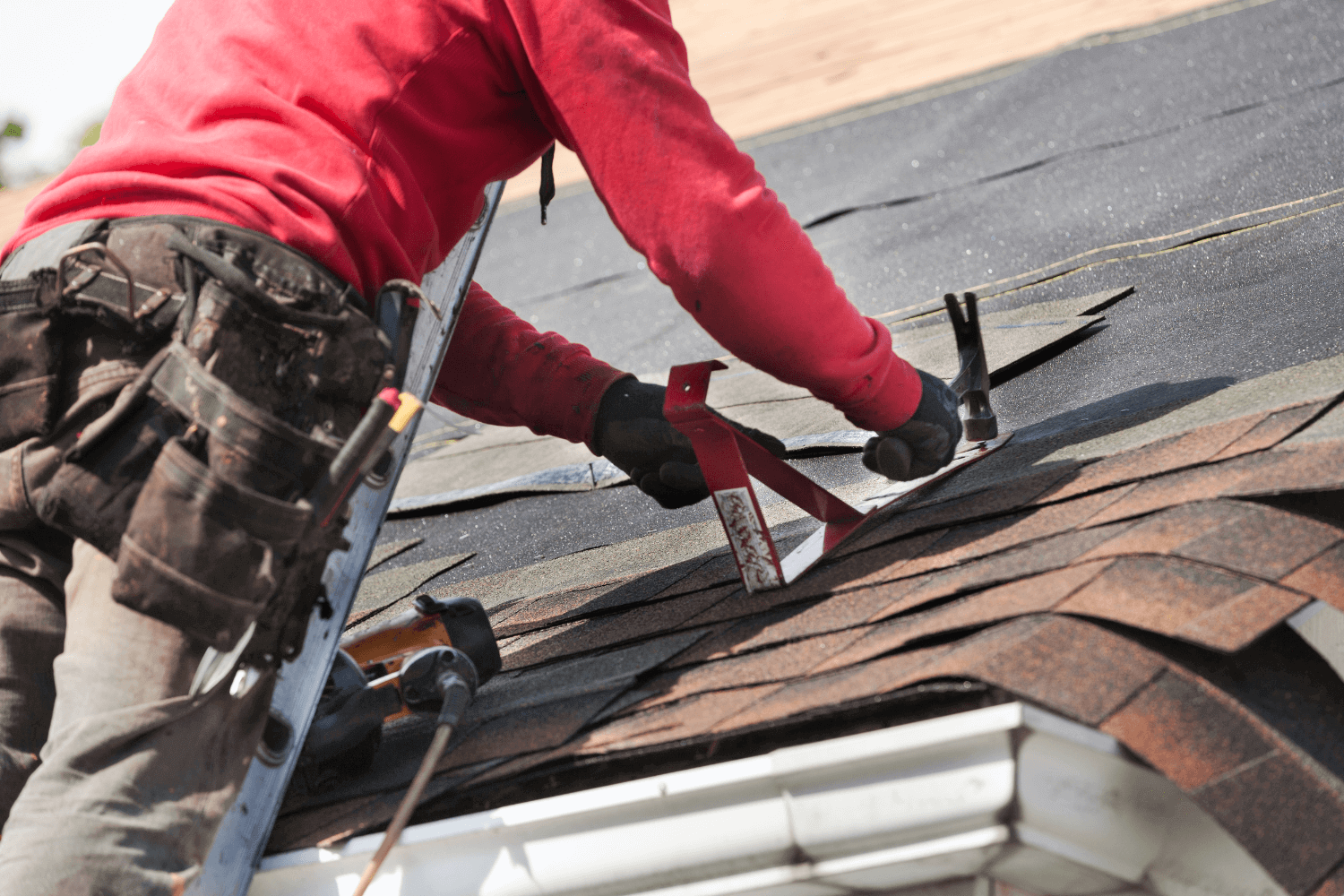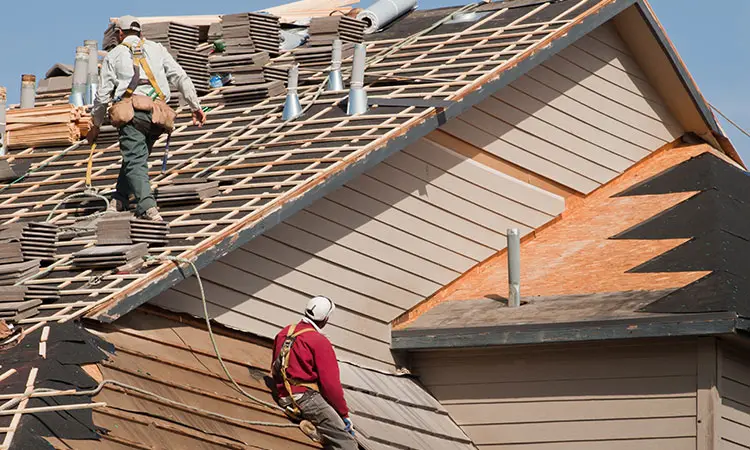Seasonal Roofing System Repair List: Prepare Your Roofing for every single Weather Condition
By complying with a seasonal roof repair work list, you can stay ahead of prospective concerns. Allow's check out just how proper upkeep can safeguard your home and extend your roofing system's lifespan.
Checking Your Roof Covering for Winter Readiness
As winter season methods, it's necessary to check your roof to confirm it can stand up to rough weather conditions. When snow and ice gather, Start by checking for missing out on or damaged tiles; even a little concern can lead to substantial leaks. Next off, check out the blinking around vents and chimneys-- this location is usually at risk to water intrusion.
Don't neglect to look for indications of drooping or irregular surface areas, as these might show structural issues. Furthermore, confirm your seamless gutters are clear; clogged rain gutters can bring about ice dams that damage your roofing system.
 roof repair
roof repair
Springtime Cleaning: Clearing Up Particles and Checking for Damage
As soon as winter's grasp releases, it's time to deal with spring cleansing on your roof covering by eliminating debris and looking for any damage. Start by inspecting your roof for fallen branches, leaves, and other debris that can catch moisture and trigger rot. A tidy roof covering advertises much better water drainage and prevents mold and mildew growth.
Next, get a strong ladder and very carefully inspect tiles for splits or missing out on items. Take notice of areas around vents and smokeshafts, as these spots are vulnerable to leakages. Don't neglect to examine your gutters, guaranteeing they're without clogs that might result in water merging.
While you're up there, search for signs of wear, like corrosion on steel blinking or loose seals around skylights. Addressing them currently can conserve you from costly repairs later on if you detect any kind of problems. A little spring cleaning goes a lengthy means in preserving your roofing system's integrity.
Summertime Heat: Analyzing Your Roofing for Heat-Related Issues
As summer season heat magnifies, it's important to examine your roofing system for heat-related concerns. Look for any roof shingles damage, seek indicators of warm fastening, and examine exactly how well your roof covering ventilates. Taking these actions now can avoid larger troubles in the future.
Inspect for Roof Shingles Damage
 roof repair
roof repair
Look For Warm Fastening
Warm buckling is a common problem that can roof repair gainesville ga occur throughout the scorching summer season months, and it's vital to check for it on your roofing. Begin by checking your roof covering visually; look for any unequal surface areas or raised edges. If you identify any type of indicators of warmth fastening, it's essential to resolve them quickly to avoid additional damages.
Examine Roof Covering Ventilation Efficiency
After examining for warmth buckling, it's essential to evaluate your roofing's ventilation performance. Correct air flow helps manage temperature level and dampness, stopping damages from excessive heat. Bear in mind, keeping great air flow not only lengthens your roofing system's life but additionally enhances your home's total energy efficiency, ensuring convenience throughout those hot summertime months.
Rainy Period Preparedness: Guaranteeing Correct Water Drainage
As the stormy season techniques, you need to ensure your roof's water drainage system prepares to handle hefty downpours. Beginning by examining your downspouts and rain gutters, and make certain they're free from particles. Don't forget to check the flashing and seals to protect against leakages and water damages.
Examine Downspouts and seamless gutters
During the stormy period, it is crucial to frequently evaluate your downspouts and seamless gutters to guarantee appropriate drain. Start by checking for any kind of visible debris, like branches or fallen leaves, that can obstruct the circulation of water. See to it the gutters are firmly affixed and devoid of sagging, as this can trap water and lead to leakages. Next, check out the downspouts for obstructions or damage; an obstructed downspout can create water to overflow, potentially destructive your roofing and foundation. Validate that downspouts direct water away from your home's foundation. Resolve them promptly to prevent pricey repair services if you identify any type of problems. A little upkeep currently can conserve you large headaches later when hefty rainfalls hit.
Tidy Roofing Surface Debris
Utilize a roofing rake or mop to carefully get rid of particles, being careful not to damage the roof shingles. After cleaning, check your roof covering after hefty rains to identify any potential concerns early. Maintaining your roof covering clear of debris is essential for preventing costly repairs down the line.
Check Flashing and Seals
After removing your roofing of debris, take a more detailed look at the flashing and seals around smokeshafts, skylights, and vents. These locations are crucial for avoiding leaks throughout the rainy season. Examine the blinking for any indicators of rust, splits, or spaces. If you discover any damage, it is very important to repair or replace it without delay. Next, check the seals; they must be undamaged and limited. Search for any peeling or worn-out locations that might enable water to permeate in. Think about resealing them with a high-grade roof covering sealant if you discover any kind of compromised seals. Ensuring these components remain in good condition will help maintain correct water drainage and safeguard your home from water damage throughout heavy rainfall.
Checking and Keeping Roofing Seals and Flashing
While it might appear very easy to overlook, examining and keeping roofing seals and flashing is vital for stopping leakages and water damages. Start by evaluating the seals around skylights, vents, and smokeshafts. Search for any splits, spaces, or indications of wear. If you identify any kind of concerns, it's ideal to reseal them with proper roof sealer to assure a tight fit.
Next, examine the flashing, which guides water away from important areas. Check for corrosion, loose sections, or bent edges. If you find any type of broken blinking, change it or safeguard it properly to keep its integrity. Bear in mind, also a little flaw can bring about significant problems down the road.
Lastly, don't forget to clean off any debris that might block the seals or blinking. Keeping these elements in good form will assist secure your roofing system versus the elements and expand its lifespan.
Seamless Gutter Maintenance: Keeping Water Flowing Smoothly
Because your rain gutters play an essential duty in directing rain away from your home, regular upkeep is critical for stopping water damages and foundation concerns. A stopped up seamless gutter can lead to water overflow, which may damage your roof and siding.
If you discover any kind of damages, repair service or replace the damaged parts quickly. Confirm downspouts are routing water at least six feet away from your foundation.
Ultimately, inspect that your gutters are appropriately sloped, ideally a quarter inch for every 10 feet. This slope guarantees water moves smoothly towards the downspouts. Normal maintenance will certainly keep your seamless gutters operating effectively and shield your home from expensive repairs.
Scheduling Professional Evaluations for Comprehensive Treatment
Routinely scheduling expert assessments is vital for preserving your roofing's honesty. This timing allows you to address any kind of damages caused by winter climate or summer season storms.
Throughout evaluations, specialists will evaluate shingles, flashing, and ventilation, ensuring whatever's in top form. They'll also look for indications of wear, leakages, or mold, which you may overlook. Setting up these assessments not just extends your roofing's lifespan however additionally offers you comfort.
If you're unclear about the problem of your roofing, do not think twice to call a professional. Buying these examinations now can conserve you a whole lot later. Prioritize your roofing system's wellness, and you'll be well-prepared for whatever weather comes your way.
Frequently Asked Questions
Exactly how Usually Should I Evaluate My Roof Covering Throughout the Year?
You must examine your roof covering at the very least twice a year, ideally in springtime and autumn. After severe weather condition events, look for damage as well. Normal inspections help you catch issues early and save money on repair services.
What Indicators Suggest I Required a Roofing Replacement Rather Than Repair?
 roof repair
roof repair
Can I Carry Out Roofing System Fixes Myself, or Should I Hire a Professional?
You can perform minor roof covering repairs yourself if you're comfy with elevations and fundamental tools, yet hiring a specialist assurances security and correct job. Don't run the risk of damage; it could be worth the financial investment for assurance.
What Are the Finest Products for Roof Fixes in Various Climates?
For various climates, you'll want materials like asphalt shingles for moderate locations, steel roofing for extremes, and clay ceramic tiles for hot regions. Constantly take into consideration local climate patterns to ensure your roofing system withstands the components efficiently.
Exactly How Do Roof Warranties Affect Seasonal Maintenance Responsibilities?
Roof covering service warranties often specify maintenance duties, so you'll need to examine the terms. If you don't maintain your roofing system as required, you could void the guarantee, leaving you in charge of pricey fixings.
Seasonal Roofing Repair Service List: Prepare Your Roof Covering for Every Climate
When winter months's grasp releases, it's time to deal with spring cleaning on your roof by clearing away particles and inspecting for any type of damages. Examine for any kind of tile damage, look for signs of heat fastening, and examine how well your roofing ventilates. If you find any concerns, take into consideration speaking to a professional for repair work to keep your roof in leading form and shield your home from possible water damages.
While it could seem simple to overlook, maintaining and inspecting roof seals and blinking is important for stopping leaks and water damages.